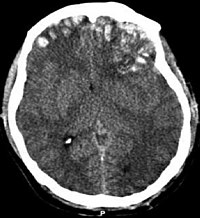
Photo from wikipedia
PURPOSE In adults, shock index (SI; heart rate/systolic blood pressure) >0.9 predicts injury severity and trauma outcomes. However, age-adjusted shock index (SIPA) out-performs SI in blunt trauma patients 4-16years old.… Click to show full abstract
PURPOSE In adults, shock index (SI; heart rate/systolic blood pressure) >0.9 predicts injury severity and trauma outcomes. However, age-adjusted shock index (SIPA) out-performs SI in blunt trauma patients 4-16years old. We sought to confirm these findings and expand this tool to include penetrating trauma and children aged 1-4years. METHODS We developed cutoff values for patients 1-3years old using age-based vital signs and queried the 2014 Pediatric Trauma Quality Improvement Program (TQIP) database for patients aged 1-16years sustaining blunt or penetrating trauma. Outcomes measured included injury severity, transfusion within 24h, intensive care unit (ICU) and hospital length of stay (LOS), and mortality. SI and SIPA were compared using Student's t-test and chi-square tests. RESULTS We identified 22,344 blunt and 613 penetrating trauma patients. SI was elevated in 41.3% and 40.0% of these groups, respectively, whereas SIPA was elevated in 15.6% and 19.4% of patients. SIPA was a significantly better predictor of transfusion needs, injury severity, ICU admission, ventilator use, and mortality for both blunt and penetrating trauma. CONCLUSION SIPA identifies severe injury and predicts transfusion needs and mortality more effectively than SI for both blunt and penetrating pediatric trauma. Further investigation should evaluate its use as a triage tool. TYPE OF STUDY Prognosis Study. LEVEL OF EVIDENCE II.
Journal Title: Journal of pediatric surgery
Year Published: 2017
Link to full text (if available)
Share on Social Media: Sign Up to like & get
recommendations!